
bolewts58
-
Posts
603 -
Joined
-
Last visited
-
Days Won
9
Content Type
Profiles
Forums
Blogs
Gallery
Events
Store
Posts posted by bolewts58
-
-
12 minutes ago, dedehansen said:
Hi Brian, I was asked for my opinion and so I did.
I didn´t say that it is a fake.Regards
AndreasSorry. I misunderstood your post that you didn't like it to mean you thought it was fake. Perhaps you meant that you didn't think it was an early issue one. I think it is. So, on that we disagree. Eric however said flatly it's fake and he's of course entitled to his opinion.
0 -
We're talking about probably 2 to perhaps 4 different finishes: oxydized metal (brass or tombak), blackened metal and perhaps bluing and silvered. It's not uncommon for several different finishes to exist on one maker's pieces. Steinhauer & Luck had 2 different finishes for its metal SA listed in its 1939 catalogue. The large number of Meybauer variations (more than a dozen) on the Silesian Eagle is a testament to what could be commerically available from one maker.
If you look at this group to Gren. Paul Rohde, that I posted last year, the 1st class pictured is of a similar type, but has a silvered finish (mostly worn off on the obverse, but present on the reverve). The reverse is partially hollow. But, other than that, it's very similar. I believe it's likely from the same maker, but from a die that had a male reverse leaving the partial hollow.
http://gmic.co.uk/topic/8598-schlesischer-adler-silesian-eagles/?do=findComment&comment=621502
Here is a close-up of the 1st class.
Actually, Bruniert means "bronzed" or "burnished". Bluing is " gebläut".
By the way, my name is Brian, not Tim.
I've been collecting Freikorps since 1969, back when I think only Verkuilen Ager and I were pretty much the only collectors of the stuff. So, I'm not a newbie. But, I'm not infallible, which is why if necessary I provide empirical evidence (which I have done) to back up my opinions, All you and Dedehansen have done (so far) is express unsubstantiated opinions. I'm not disputing your knowledge and expertise, which is well-known. But, here opinion alone, when expressed by 3 knowledgeable people isn't enough. I have provided expert proof from someone who is universally recognized by long-standing Freikorps collectors as the authority on the Silesian Eagle. Konstantin is active on several forums: several Russian forums, WAF and in particular the German forum Feldgrau where he is known by the handle, Tom63. He is recognized as the go-to guy by hard-core Freikorps collectors on any Freikorps pieces under discussion. So, my reference above is pretty rock solid.
If you can counter it with the equivalent, I will accept your opinion. Otherwise, I think at least in this issue, my opinion holds the advantage.
0 -
I still disagree with both of you. Here is the same SA in 1st class from Konstantin Nikolaev's book on the Silesian Eagle. It has the same feather configuration, rivet holes, pins, cross and crescent, "FÜR SCHLESIEN" cartouche and reverse striation as the 2nd class in question. I'll revise my remarks and say that it isn't "Brauniert", but oxydized tombak or brass (hard to tell in the photo). Part of the Russian inscription on this page states that the eagle was made of oxidized metal.
I owned a similar 1st class 40 years ago in blackened brass; long before anyone was faking these. There is no doubt that it's a period piece.
Konstantin is recognized as one of the world's leading experts on all things Freikorps, particularly the Silesian Eagle and Baltic Cross. If he accepts this type as genuine, it is genuine.
0 -
So have I. I've been collecting them since the late 1960s. I will however look for the example in question in Konstantin's book to verify what I am saying.
0 -
1 hour ago, Gerd Becker said:
I had this in my odds and ends box for years and allways thought it to be some kind of schützenfest relatet cap badge or something, but only today i found out, its probably a Freikorps cap/collar badge of the Freiwilliges Landesschützenkorps (according to weitze at least). Its really well made and heavy for a hollowback badge and the frosted finish is pretty neat.
Is this a legit piece?
Yes. This is the cap badge of the Freiwilliges Landesschützenkorps. It went around the top cockade of the Feld-mutze. There was a pair of corresponding collar badges that had a closed round wreath.
0 -
Flieger Abteilung der Württembergische Freiwilligen Abteilung (Freikorps) Haas
Unit Breast badge instituted some time between May and September 1919 for the flying unit of Freikorps Haas. The badge apparently also came in a version for sewing on the uniform. I personally believe the badge was more of a commemorative service badge than simply a unit badge, as it probably didn't come into existence until after the unit's operational actions.
Württembergische Freiwilligen Abteilung Haas was formed in Münsingen, Württemberg in February 1919 by Generalmajor Otto Haas with a strength of 2376 men. The principal actions of the Freikorps were fighting against the Bavarian Soviet in Augsburg in April and the main battle in Munich in May 1919, as well as later in 1920 in the Ruhr, as part of Reichswehr-Brigade 13.
As far as I've been able to determine from research, the Flieger Abteilung of Freikorps Haas was formed in April 1919 and took part in the assault on Munich on May 3. 1919. They were likely nominally attached to Freiwilligen-Flieger-Abteilung Dessloch of Freikorps von Epp (commanded by Lnt. Otto Dessloch, former WWI Squadron leader of Bavarian Jagdstaffel 17 and later Generaloberst der Luftwaffe and winner of the Knights Cross with Oakleaves). The Flieger Abteilung of both Freikorps Hass and von Epp only lasted until September 1919 and then were disbanded as per the Treaty of Versailles.
If the Flieger Abteilung followed WWI Feld-Flieger-Abteilung composition structure, it likely had no more than 6 planes, making this badge extremely rare.Eiserne Eskadron / Freiwilligen-Eskadron Krossa / Freiwilligen Braunschweig Husaren-Regiment Nr.17
1/ Collar Badge
2/ Photo of Eiserne Esk. members
3/ Editorial and Recruiting Poster
The Freikorps was formed on January 31, 1919 as part of Freiwilligen-Division von Lettow-Vorbeck of the Garde-Kavallerie-Schützen-Korps in Berlin.
Fought against the Spartacists in March in Berlin and later joined Division Gerstenberg and fought against Socialist forces in Bremen.0 -
On 3/12/2016 at 23:43, dedehansen said:
Hi Alex,
I don´t like this Silesian Eagle
Kind regards
AndreasI believe it sold for 56 Euros on eBay. Why don't you like it? I think it's ok. In fact, I think it's typical of early ones made with wire prongs instead of rivets. The brown finish is a known type referred to as "Brauniert" in German. This type is shown in Konstantin's book on the Silesian Eagle.
0 -
Is is possible the negative was reversed when it was printed?
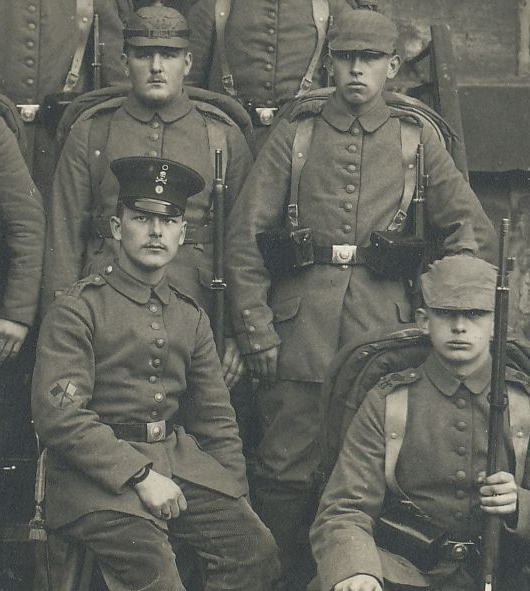 0
0 -
On 2/10/2016 at 05:57, GODISHIGH said:21 hours ago, GODISHIGH said:
also my money limit is $300.00 and im only interested in Imperial medal bars
Hello, im looking for named medal bars preferably with documents. If anybody has any for sale let me know
Thanks
JohnThis is not much money for medals and documents unless you're looking for something pretty low-end.
0 -
a pair of collar badges.
Freikorps era MG badge with black velvet backing.
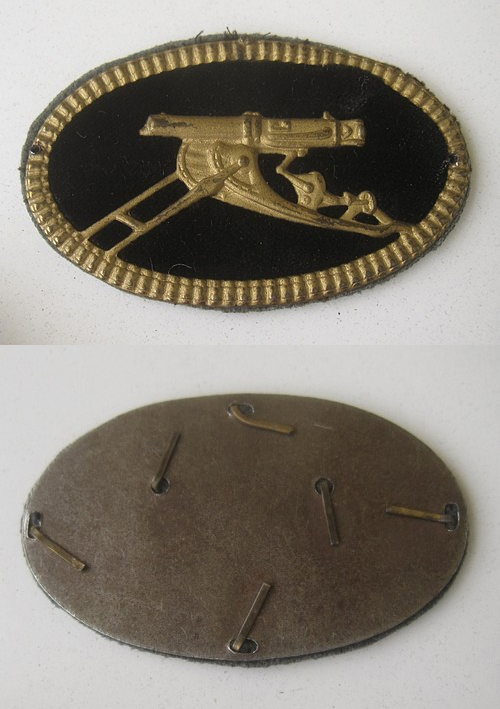
arm badge of the III Abteilung.
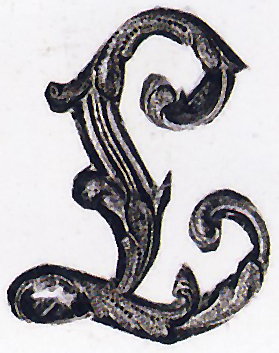
Information about the Freiwilliges Landesjägerkorps can be found here:
http://de.metapedia.org/wiki/Freikorps_Landesj%C3%A4ger
0 -
12 minutes ago, Chris Boonzaier said:
Muchos Grazias.
Is there anything on the runic that denotes a rank of any kind?
Unfortunately, no. But, he was most likely a staff officer. This photo is probably no later than March, 1919 based on the uniform. After that, he would likely have had the early Reichswehr whip-cord shoulder boards.
0 -
Freiwillges Landesjägerkorps (silver collar badges)
III Abteilung des Stabes der 1. Landesjäger-Brigade (denoted by the silver "L" on the sleeve)
The "L" sleeve badge and the black backing on the MG badge (a trend among the Freikorps) make this an especially interesting photo.
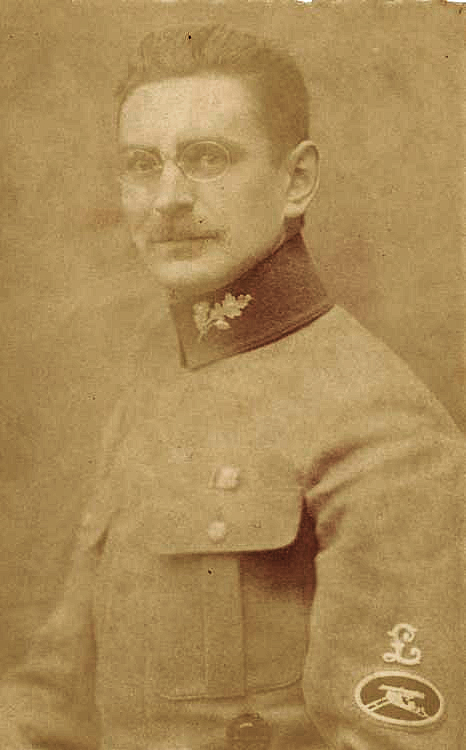 0
0 -
I believe that this uniform is Weimar era forestry service. But, I don't know what the patch would be for.
0 -
No. Militarpasses and Soldbuch's never listed street addresses, as far as I know. He lived in Altona which is a district of Hamburg.
You post a lot of documents on WAF and here. It might be a good idea to learn to read German. You'll get a lot more out of all of this.
0 -
That's a pretty impressive list of medals.
0 -
-
Nice image. anything on the back?
0 -
2 hours ago, Hermann said:
First letter is a "P", so could be read as "Pense" (Poensgen?).
No it's not a P. It is a Kurrentschrift V.
I now think it's actually "Verstr." But, if so, I don't know what that abbreviation would be.
0 -
47 minutes ago, The Prussian said:
Hi Andreas!
I have some difficulties to read...
1.12.17: zur 2.Kp./Ersatz ??? Inf.Rgt.75
15.4.18: Genesenen-Kp. Inf.Rgt.75
25.5.18: ?
6.2.19: Detachement Küntzel Garde-Kav.Schtz.Div.
2.6.19: I.Ersatz Freiwilligen Komp. IX.AK Altona
14.9.19: Feld??? 1203
21.6.19: Mannschafts-Ersatz-Depot Brigade Litauen
20.10.19: 3. ??? Inf.Rgt. Stab Eiserne Division Kurland
10.6.20: zum I./13, 2.Kp. Libau
29.5.20: Inf. ??? ??? I/13
Can youb read more? He seemed to change his unit after the actions in Kurland/Litauen
I think 1.12.17: zur 2.Kp./Ersatz ??? Inf.Rgt.75 is just 1.12.17: zur 2.Kp./Ersatz Inf.Rgt.75 (Esz.). There's not another abbreviation there.
25.5.18: ? = 25.5.18 entl. (entlassen) - discharged
14.9.19: Feld??? 1203 = 14.9.19: Feldäckereikolone 1203
20.10.19: 3. ??? Inf.Rgt. Stab Eiserne Division Kurland = 20.10.19: 3. Kurl. Inf.Rgt. Stab Eiserne Division Kurland
The last one, I'm not sure of.
29.5.20: Inf. ??? ??? I/13 = 29.5.20: Inf. Verstn. Komp. I/13. It looks like 'Verstn.'. But, I don't know what that could mean. "Verstehenden" (comprehensive) maybe. It's a designation I don't know.
By the way, the unit in the photo is: 3. Kurland Inf.Rgt. Stab Eiserne Division Kurland.
He's wearing the Iron Division Medal and the Baltic Cross.
0 -
Great photo of a member of Freikorps Pfeffer. Interestingly, he's wearing the "Fangschnur" incorrectly. It was supposed to attach at the back of the left shoulder board button as he has done, then loop under the arm and attach at the front of the left shoulder board button (not across the chest to the button hole) so that the horse and acorns hung from the left shoulder.
I guess he didn't get the memo on how to wear it or just wanted to be different.
0 -
-
-
No, that's a round badge with Roman numeral 'I' inside a letter G surrounded by a wreath standing for 1. Landesschützen-Brigade-Garde.
The oval badge went on the officer's shoulder board.
0 -
I thought i would revive this thread with a number of items from Freikorps von Neufville (Landesschützen-Brigade Garde, Schwarze Garde, Detachement von Neufville).
Treukreuz 1st class
Treukreuz 2nd class
Contemporary newspaper article on the criteria for the Treukreuz
Shoulder board device
Stickpin of veterans of the Schwarze Garde
Sports medal for the Schwarzen Garde
Photo of Georg Rittmeister von Neufville standing in front of the Freikorps Fahnenträgern
Photo of some members of Freikorps von Neufville
Militärpass of 1. Garde Landesschützen Abteilungen (Freikorps von Neufville)
0


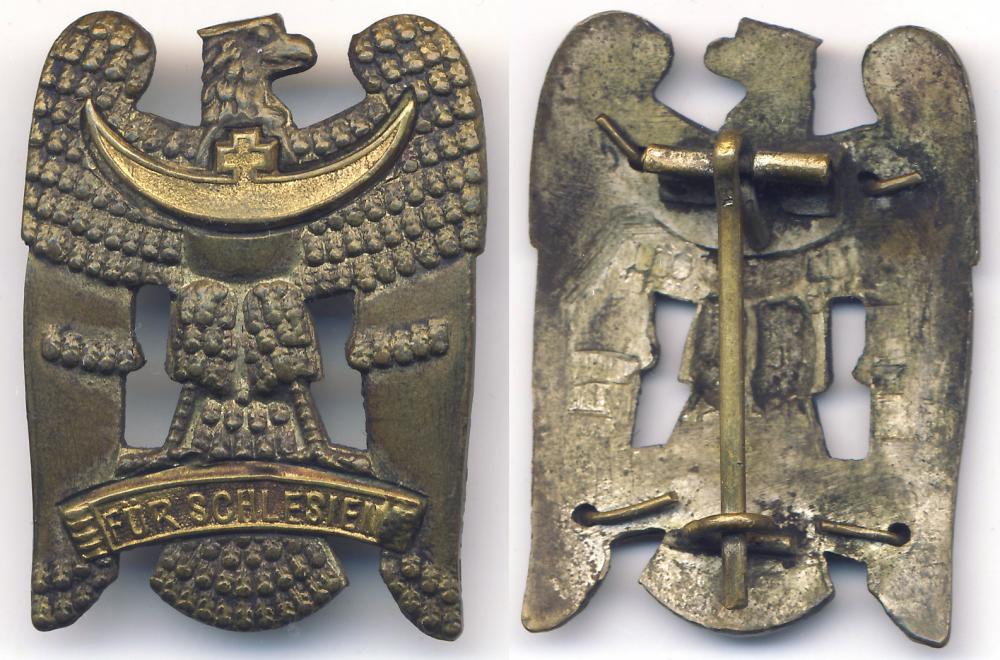


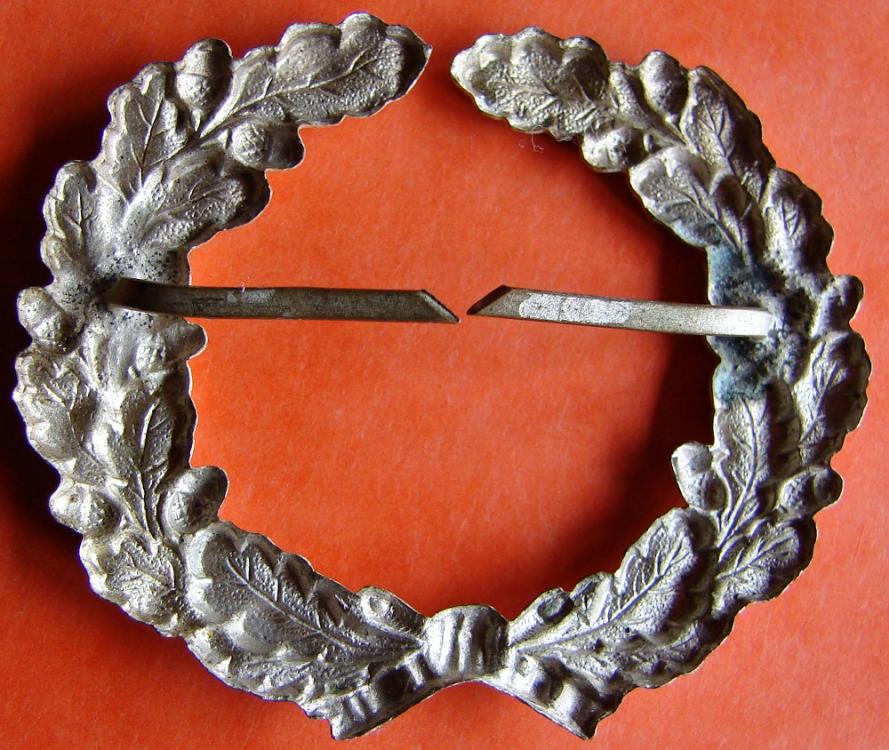
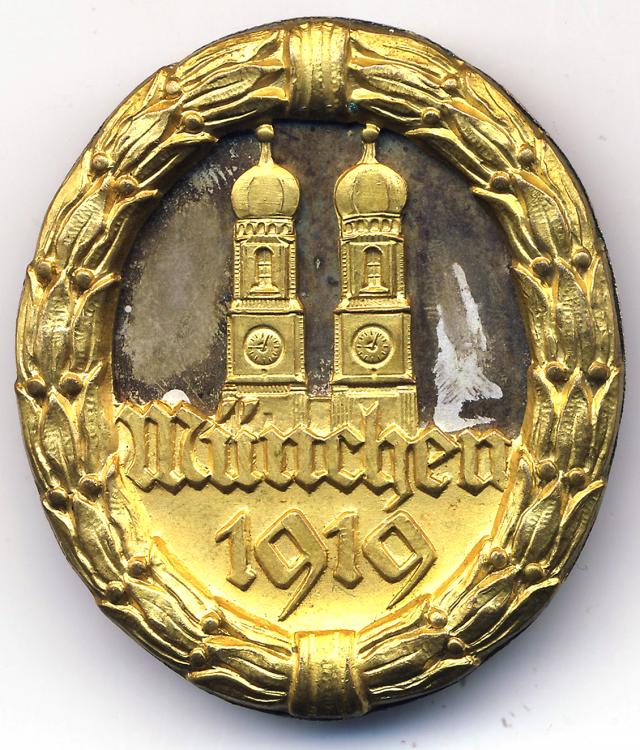
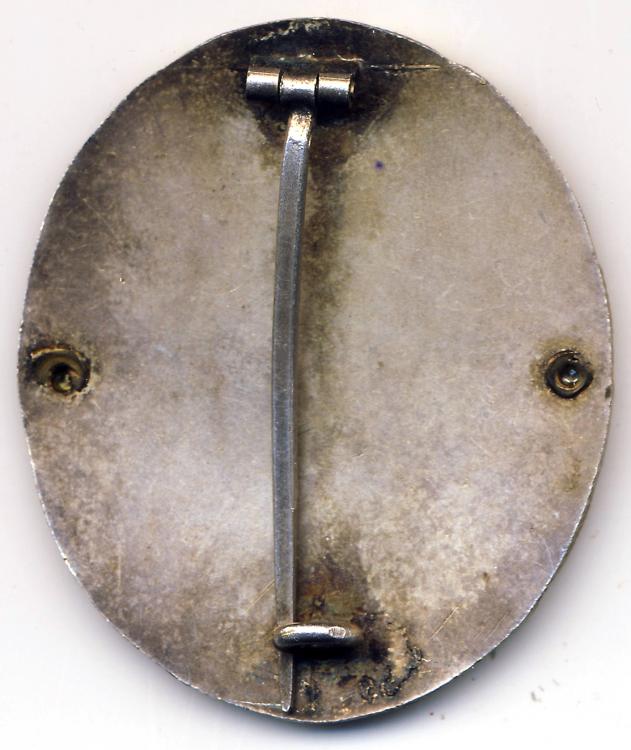


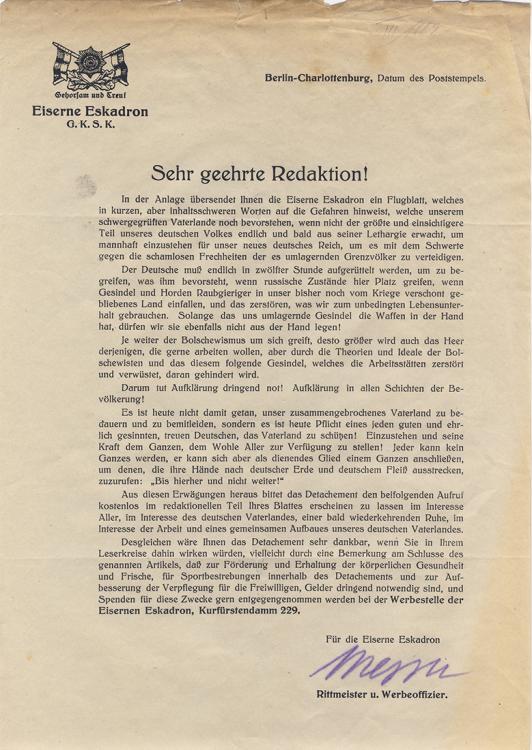
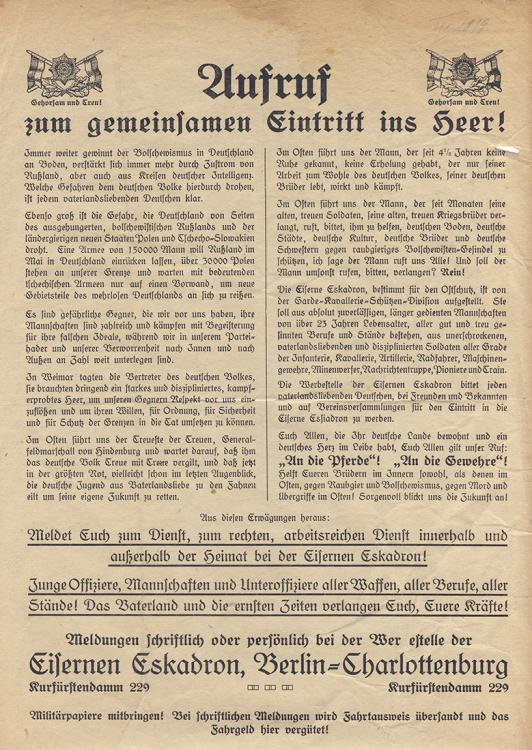
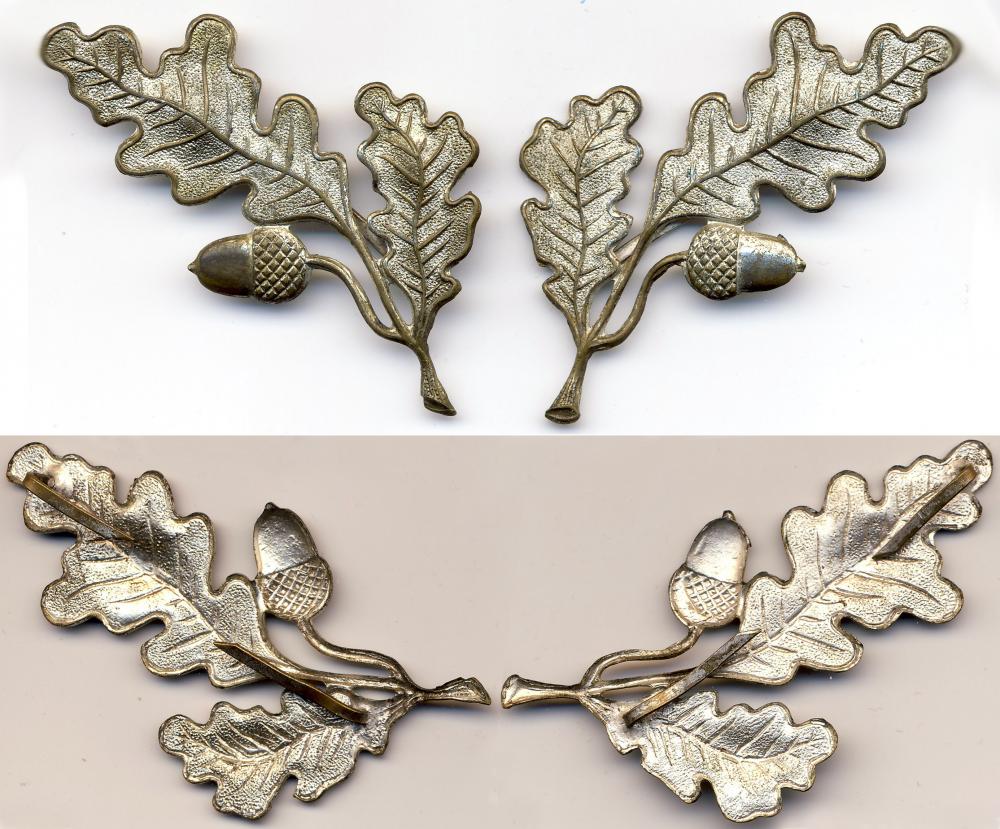
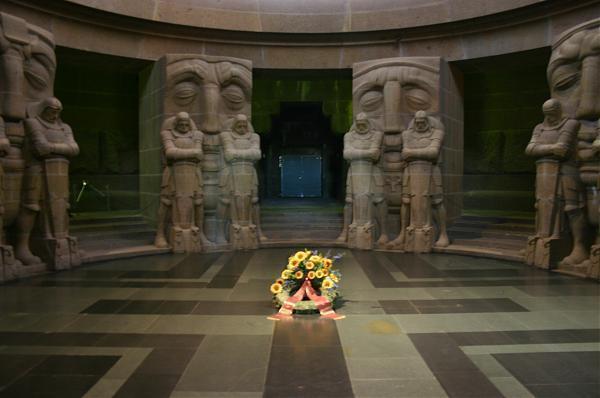
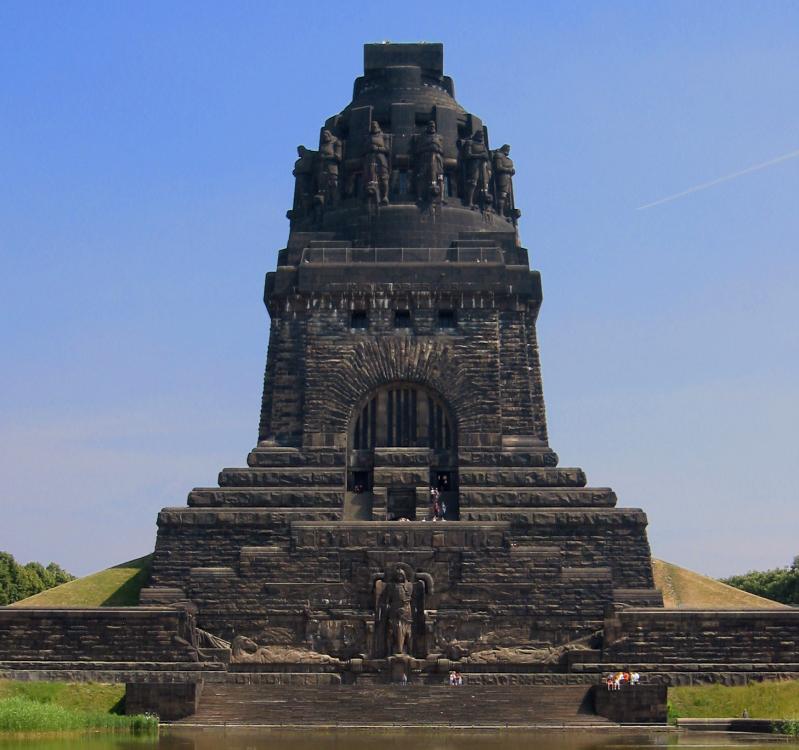
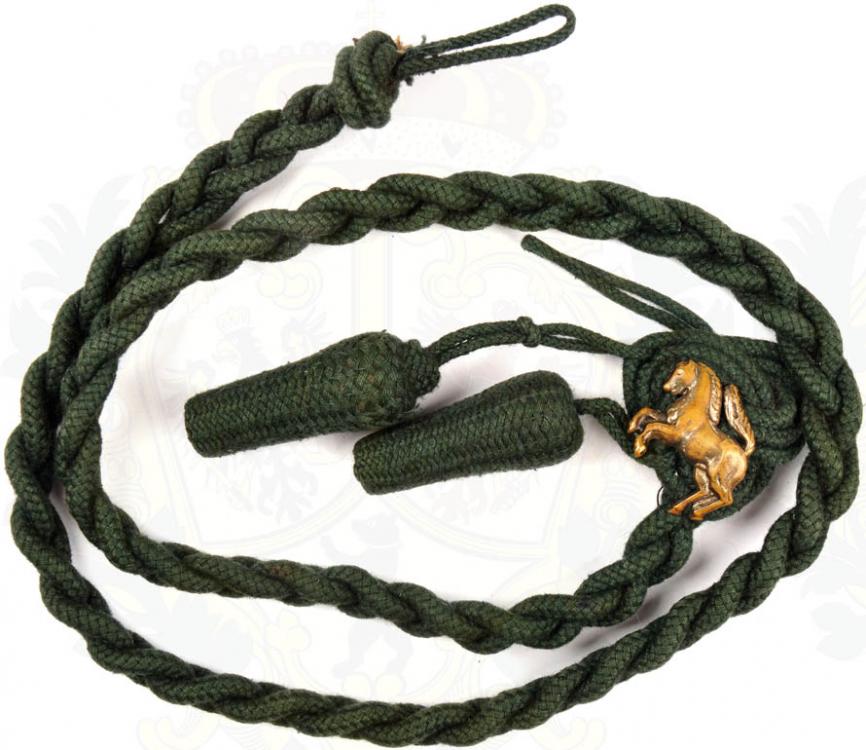
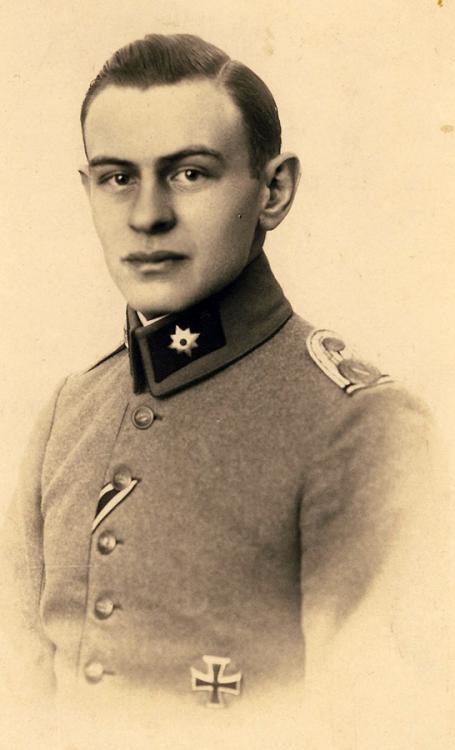
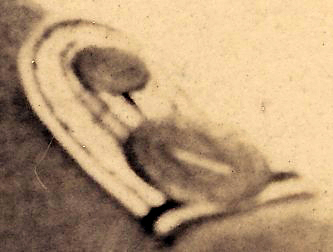
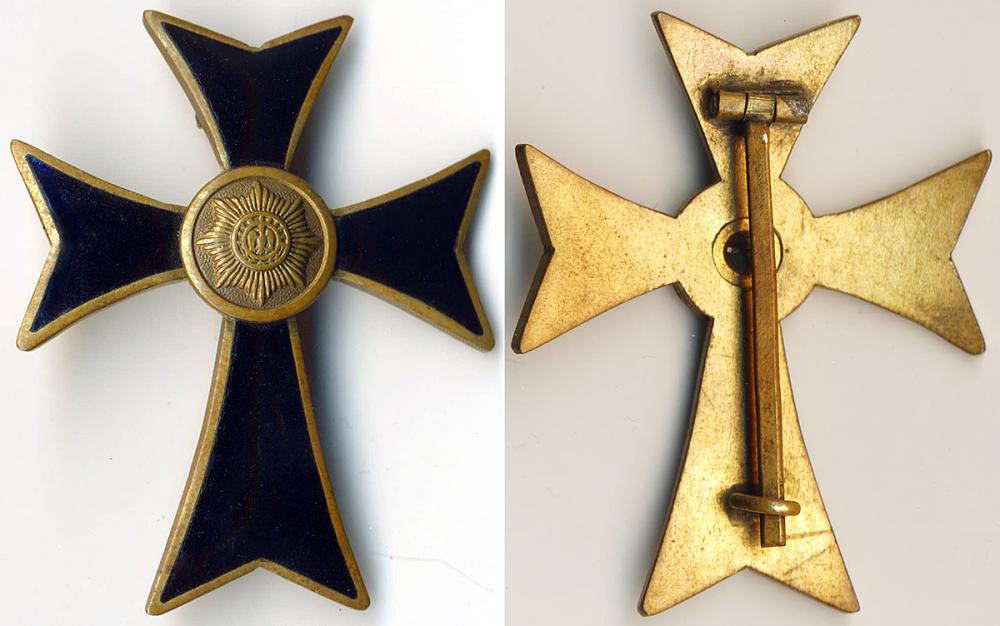
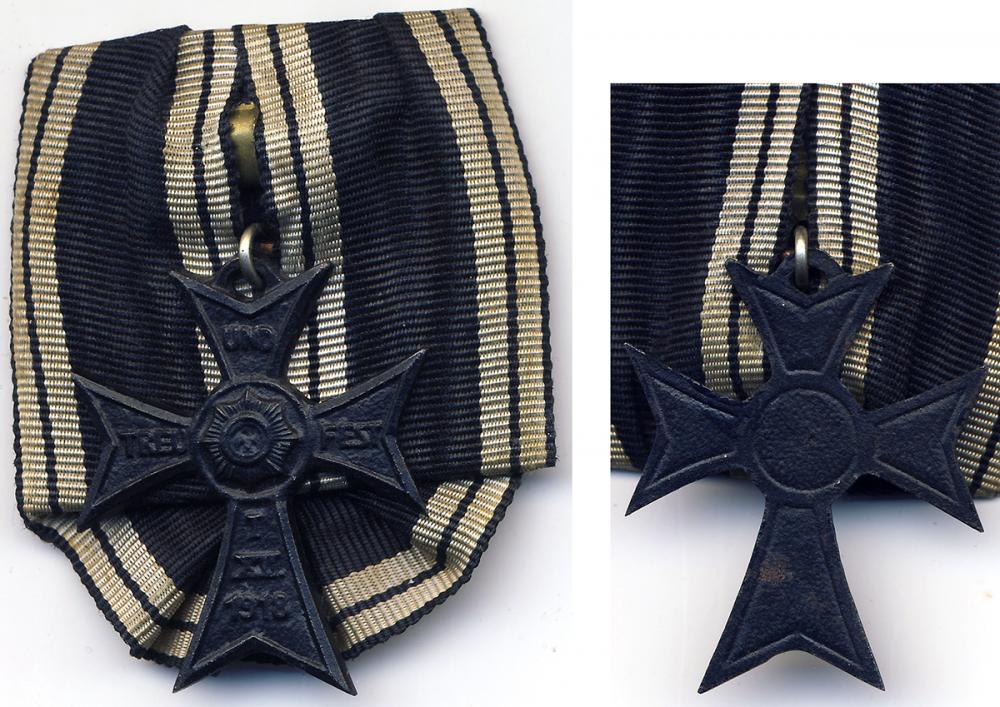
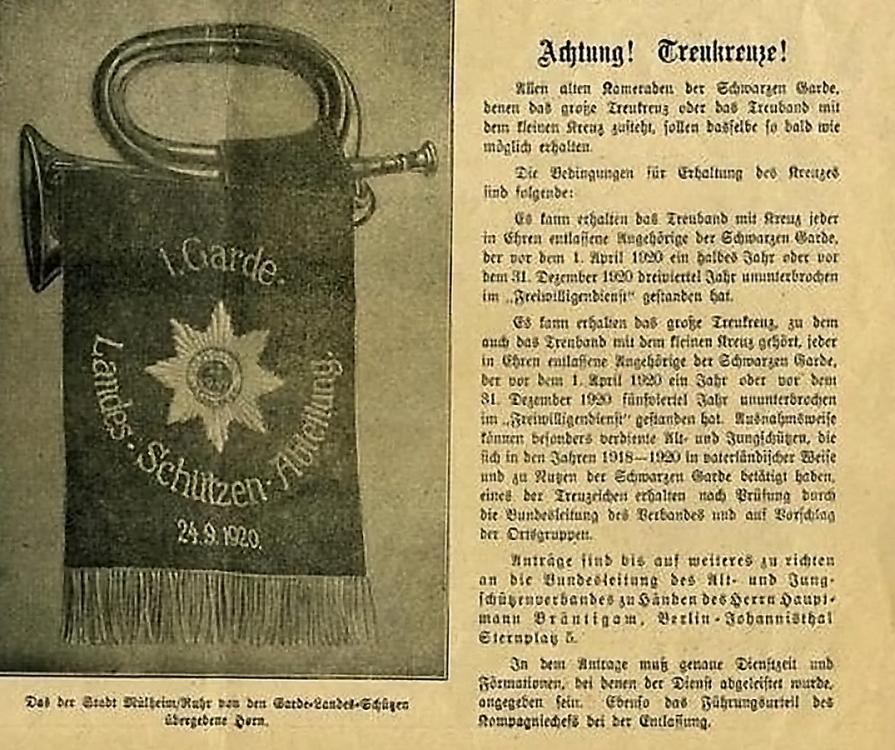
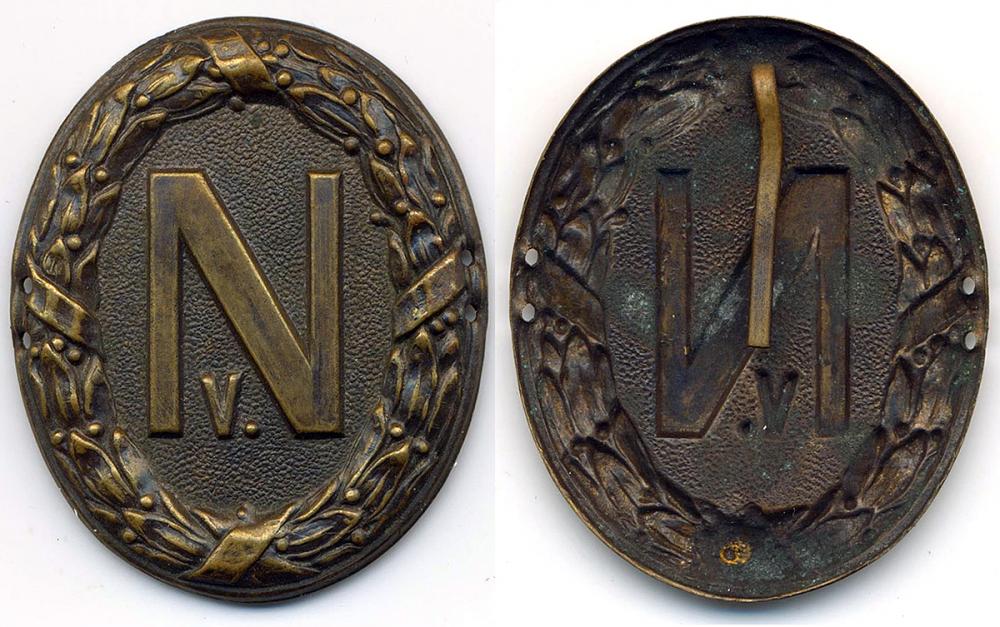

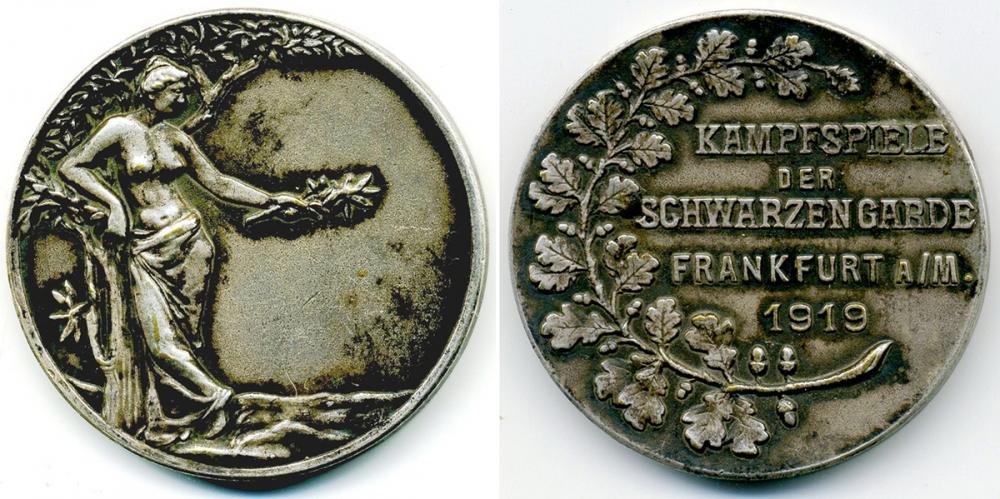

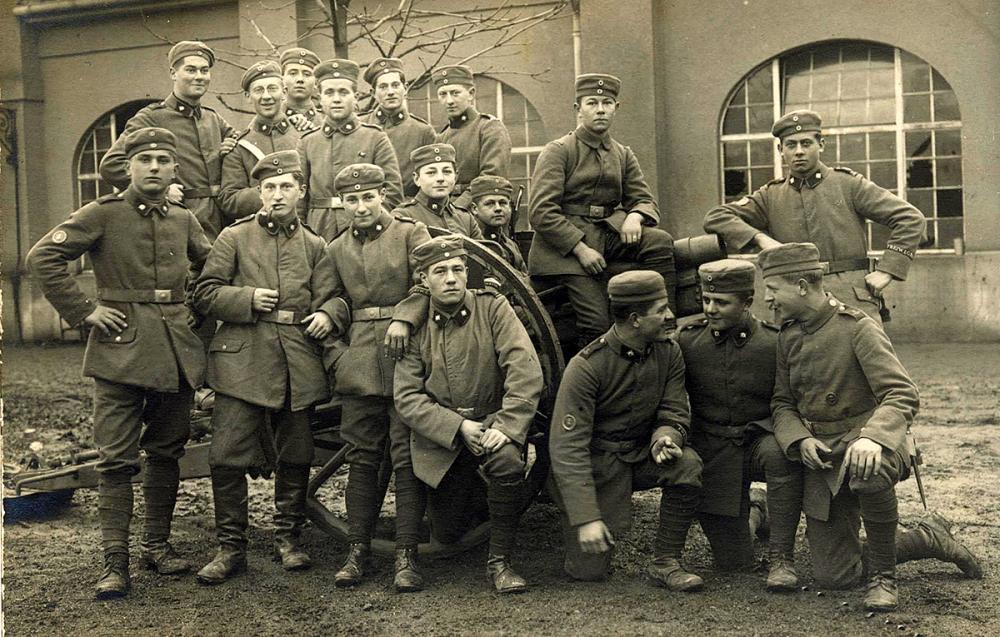

Silesian Eagle 2 class
in Germany: Weimar Republic & Deutsche Freikorps
Posted
Eric
We;re just having a friendly discussion and everyone's opinion is valid.
I find the translation of the term "bruniert" to mean bluing odd as the word literally means what I said in German - bronzed or burnished as it's root is 'brennen' meaning to burn.
I always thought the finish you're showing was referred to as "lackiert". The finish on early Baltic Crosses is a smoky blue-black like gun bluing and is always referred to as "lackiert" in my experience.